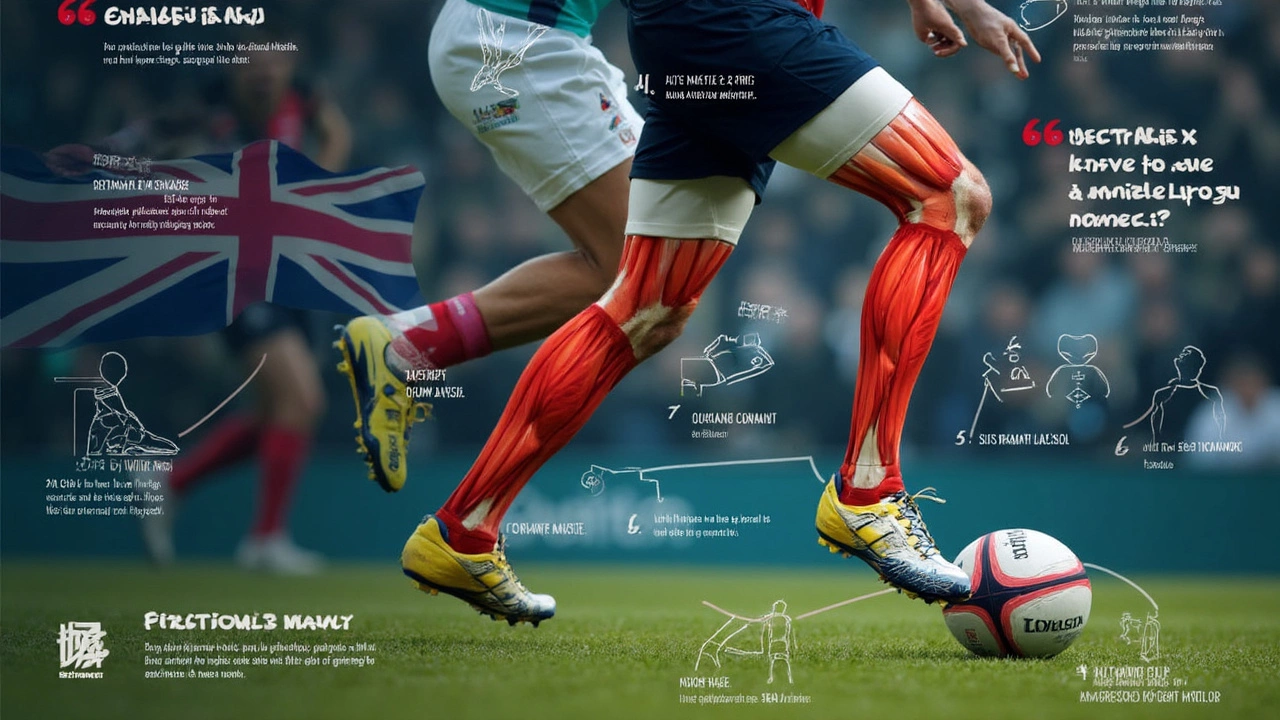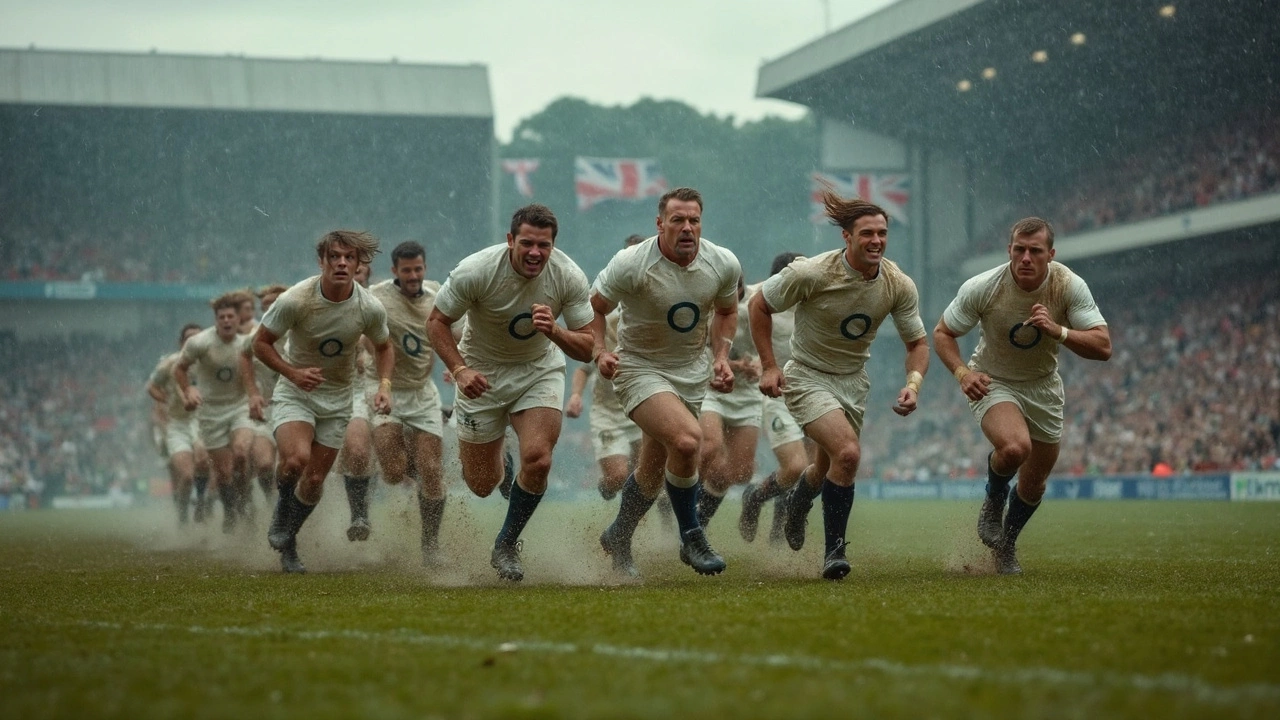Scroll through any rugby highlights, and one thing jumps out: those legs! Thick thighs, sturdy calves, and hamstrings that look like they’ve never skipped a squat day. So, what’s going on here? It’s not just for show. Rugby demands explosive speed, fierce tackles, and constant shifting from sprints to scrums. Legs do most of the heavy lifting.
If you watch a prop or a winger in action, you’ll see players shoving hundreds of kilos in a scrum, powering through defenders, or dodging tackles at full speed. All that action requires muscle—lots of it—and not just any muscle. Rugby training builds both strength and endurance, so players aren’t wobbling by halftime. The result? Powerful, thick legs that can take a beating and keep going.
It goes beyond just looking tough in shorts. Having big, strong legs helps prevent injuries. A tight, muscular lower body stabilizes joints, so those sudden changes in direction don’t end in twisted knees. Rugby players pay close attention to this in training, mixing heavy lifts with fast drills. Don’t expect those legs to come from a few jogs around the block or casual gym sessions. It’s a full-time commitment.
- Why Rugby Legs Look Like That
- Workouts That Build Power
- Game Action and Muscle Growth
- Benefits On and Off the Pitch
- Tips for Building Stronger Legs
Why Rugby Legs Look Like That
If you’ve ever stood next to a rugby player, you’ve probably noticed their legs look like they belong on a different species. It’s not all genetics—the game forces every player to pack on muscle, especially in the lower half. Rugby combines sprinting, jumping, pushing, and lots of sudden stops and starts. Each of these moves fires up leg muscles in a way that jogging never could.
During a match, rugby players run up to 7 kilometers, but it’s never at the same pace. There’s sprinting after a breakaway, digging in to tackle a charging opponent, or driving your way forward in a scrum. Those short, sharp bursts put huge demands on quads, hamstrings, and calves. Muscles adapt by getting bigger and stronger. It’s simple body mechanics—work them hard, and they’ll grow to meet the job.
No other sport puts the lower body through the blender quite like rugby. Scrums are a perfect example. In a single scrum, players might be pushing against 800 kilograms of brute force. It’s a legs-only war. That repeated strain leaves no choice but to build up serious muscle. If your legs can’t pull their weight, you’re getting tossed all over the pitch.
It’s also about surviving hits. Big, solid legs soak up contact and help players bounce straight back up after a knock. Strong legs mean better stability, so there’s less risk of being taken out by a bad tackle or rolling ankles on a rough pitch.
So, if you see those giant quads and wonder what’s up, it all comes back to the way rugby players train for pure grunt and constant action. When the game demands max leg power, you get bodies built for the job—no shortcuts, just real work for real results. That’s why you’ll always spot rugby legs a mile away.
Workouts That Build Power
If there’s one thing rugby players never skip, it’s intense leg workouts. Building those massive thighs and rock-solid glutes is a mix of heavy weight training, smart drills, and pure grit. You can’t get rugby legs by doing endless running or machines alone. It’s about power moves, real weights, and a tight training plan.
Most pros keep their rugby legs in shape with old-school basics like squats and deadlifts. Here’s a look at the moves you’ll find in nearly every top player’s gym routine:
- Back Squats: Key for building raw strength. Players load up heavy, focusing on perfect form and deep reps. Some props squat over 200kg regularly.
- Power Cleans: Used for explosive speed, especially for quick bursts and tackles. This move teaches legs and hips to fire fast.
- Lunges: Not just for balance, but serious muscle building. Heavy walking lunges with dumbbells hammer the quads and glutes.
- Romanian Deadlifts: These hit the hamstrings hard, making legs both strong and flexible—ideal for sprinting and dodging tackles.
- Plyometrics: Box jumps, jump squats, and sprint intervals crank up explosive power. Players often do these right after lifting heavy.
Rugby gyms aren’t shy about mixing things up either. Players may pull sleds, flip tires, or even go uphill sprinting. A typical week will combine power and speed so muscles can handle whatever the game throws at them.
| Day | Main Focus | Notes |
|---|---|---|
| Monday | Heavy Squats & Lunges | Strength |
| Wednesday | Plyometrics & Sprints | Explosive Power |
| Friday | Deadlifts & Cleans | Total Body Power |
It’s not just about picking up big weights. Good rugby coaches insist on perfect form and full recovery between workouts. Players also mix in prehab and mobility drills to keep knees, hips, and ankles happy. Mess up technique, and you’re asking for injuries.
If you’re serious about bigger, stronger legs, try adding one or two of these power moves each week. No fancy gear needed. Just some determination—and maybe a good playlist to help you through those squats.

Game Action and Muscle Growth
The action on a rugby field is a non-stop test for any athlete’s legs. Rugby is a sport that combines short, hard sprints with heavy impacts, sudden direction changes, and long stretches of pushing, shoving, or holding ground. These game moments trigger muscle growth in ways that regular gym workouts can’t touch—mainly because of how often the body is pushed to the max under real pressure.
Every scrum, ruck, and maul is like a full-body squat under heavy load. Professional rugby players move thousands of kilos during a match, whether they're locking into a scrum or driving through tackles. Studies from the University of Bath showed that forwards can experience peak forces of up to 1,500 kg during a scrum—putting the leg muscles under massive strain for short bursts.
It’s not just about brute force, though. Rugby legs need to be fast too. Sprints, jumps, and zig-zags launch the leg muscles into growth mode because they mix explosive power with real-life agility. Unlike controlled gym sessions, this action makes different muscle fibers fire together—maximum effort, again and again, every match.
- Scrums and rucks build strength and mass through heavy resistance.
- Sprints and sudden direction changes target fast-twitch fibers for speed and explosiveness.
- Constant movement means leg muscles rarely get a break, ramping up stamina.
Real match data backs up how much work legs do. A GPS tracking study during England’s Premiership rugby season found players averaged 5–7 kilometers per match, with about 10–15% of that at full sprint or high-speed running. That’s a lot of intense muscle action condensed into just 80 minutes.
| Activity | Leg Muscle Focus | Typical Match Reps |
|---|---|---|
| Scrum Pack Down | Quads, Glutes, Hamstrings | 15–25 |
| Sprints | Calves, Quads | 20–35 |
| Jumps/Lifts | Hamstrings, Glutes | 10–20 |
| Side Steps | Adductors, Calves | 25–40 |
It’s this unique mix—muscle-busting heavy efforts, speed work, and non-stop movement—that creates those trademark rugby legs. No surprise they look the way they do after just a season or two of real playing time.
Benefits On and Off the Pitch
Big legs aren’t just for smashing tackles in games. They bring real benefits even when players step off the field. For starters, researchers at the University of Bath found that rugby players with stronger leg muscles are much less likely to suffer knee and ankle injuries. Muscular legs create more stability when changing direction or when taking those nasty hits.
Speed is another big one. Ever wonder how a forward, weighing over 110kg, can outsprint you in a park run? It’s all in the legs. The power helps with fast acceleration and, in a tight game, those extra meters can mean winning or losing.
- More muscle means greater ability to absorb contact and deliver momentum in tackles.
- Strong lower bodies help with recovery after tough matches, so players are less battered between rugby fixtures.
- On the injury prevention side, big legs support ligaments and joints—saving players from long rehab stints.
But it goes beyond just sports. Rugby players often talk about daily stuff getting easier: taking stairs two at a time, moving furniture, or just carrying kids around. My wife, Celia, always says she loves how rugby training makes weekend hikes feel like a walk in the park. If you’re training your legs like rugby players, you’ll notice those everyday challenges just feel lighter.
Look at the data on strength and injury:
| Leg Power Level | Average Sprint Speed (m/s) | Injury Risk (Season) |
|---|---|---|
| High | 9.2 | Low (under 10%) |
| Medium | 8.4 | Moderate (15-20%) |
| Low | 7.9 | High (over 25%) |
It’s clear: whether you’re aiming to dominate at the next match or just want to be stronger in daily life, building powerful legs delivers, on and off the pitch. And if you want to stand out among rugby players, the work in the gym is definitely worth it.

Tips for Building Stronger Legs
If you’re looking to build legs like a rugby player, there’s no need to over-complicate things. The secret is hard work, consistency, and using the right moves. Let’s break down the most effective ways rugby players—and anyone else—can develop powerful, solid legs.
- Rugby legs don’t come from skipping leg day. Squats lead the pack. Back squats and front squats both hit your quads, glutes, and hamstrings hard. Rugby players often go heavy, with five sets of five reps at around 80% of their max weight.
- Deadlifts are another must. They hammer the whole back of your legs and build grip strength—crucial for scrums or holding your ground in tackles.
- Lunges, especially walking lunges, help balance out both sides of your body. Plus, they mimic what happens on the field with running and sudden changes in direction.
- Bulgarian split squats are a killer for balance and single-leg power. Even pro rugby centers swear by these to fix weak points.
- Plyo work (like box jumps and broad jumps) turns brute strength into explosive power. Rugby clubs often time sprints and vertical leaps to track progress.
Of course, you have to keep things safe and smart: warm up well, use proper form, and don’t try to break a record every session. Rugby coaches also pair heavy lifting with speed drills for a reason. Quick footwork ladders and shuttle runs build the kind of fitness that helps you outlast your opponent rather than just look good in shorts.
| Exercise | Main Muscles Worked | Reps/Sets (Rugby Style) |
|---|---|---|
| Back Squat | Quads, Glutes, Hamstrings | 5x5 (@80% max) |
| Deadlift | Glutes, Hamstrings, Lower Back | 5x5 (@80% max) |
| Bulgarian Split Squat | Quads, Glutes | 4x8 each leg |
| Plyo Box Jump | Fast-Twitch Leg Muscles | 3x10 |
| Sled Push | Full Leg, Core | Five 30-meter pushes |
One last thing: recovery is part of the game. Rest days aren’t lazy days—they’re when your muscles grow back bigger and tougher. Hydrate, eat enough protein, and get good sleep. If you mix these core moves with smart recovery, you’ll be well on your way to stronger legs, whether your goal is dominating on the pitch or just keeping up with your mates at the gym.
